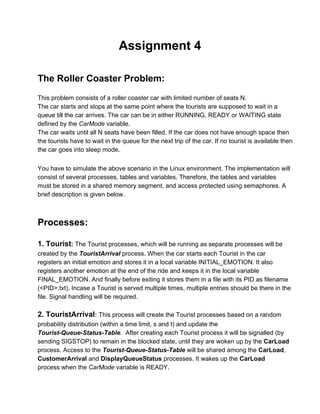
Roller Coaster Problem - OS
- 3. Data Structures: CarMode: Set as either READY, RUNNING or WAITING. TouristQueueStatusTable: For each newly arrived and lucky Tourist there will be one row in this table. This table will be shared among TouristArrival, CarLoad, CarUnload and Main processes. Each row consists of the below entries: ● PROCESS_ID ● ARRIVAL_TIME (set by TouristArrival or CarUnload) TouristStatusTable: For each served Tourist process there will be one row in this table. So Tourists who get multiple rides will have multiple entries. This Table will be shared between CarUnload, Tourist and Main. Each row consists of the below entry: ● PROCESS_ID ● ARRIVAL_TIME ● START_TIME (set by CarLoad) ● END_TIME ● WAITING_TIME CarTable: Size of this table will be limited to N. This table will be shared among CarLoad, CarUnload and Main processes. Each row consists of the below entry: ● START_TIME (set by CarLoad) ● ARRIVAL_TIME ● PROCESS_ID Emotion File: The file ‘emotion.txt’ contains a set of lines separated by ‘n’ Any one of the lines is chosen at random by the Tourist processes and used as INITIAL_EMOTION or FINAL_EMOTION.
